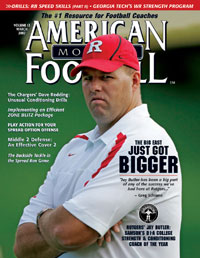AMERICAN FOOTBALL MONTHLY THE #1 RESOURCE FOR FOOTBALL COACHES
Article CategoriesAFM Magazine
|
Samson\'s Division I-A Strength and Conditioning Coach of the Year: Jay Butlerby: David Purdum© More from this issue Rutgers running back Brian Leonard knows strength and conditioning coordinator Jay Butler played a major role in the Scarlet Knights’ amazing turnaround. But that doesn’t mean he always enjoyed Butler’s tactics. “Along with the strength, conditioning and speed, he’ll do things to make you mentally tough,” said Leonard. “He’ll do the worst things you could ever think of. Like after a long day of winter conditioning, you’ll be real tired, and the next day, he’ll wake you up early and make you do three laps around the field just to piss you off. That’s just what he does, and it just makes you more mentally tough.” That’s not the only mental game Butler plays with his athletes. He loves to press their buttons and test his players anyway he can. In an effort to strengthen his receivers’....The full article can only be seen by subscribers. Subscribe today!
|
|
|||||||
| HOME |
MAGAZINE |
SUBSCRIBE | ONLINE COLUMNISTS | COACHING VIDEOS |
Copyright 2026, AmericanFootballMonthly.com
All Rights Reserved





